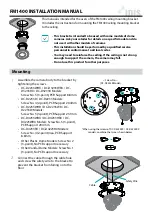
V 5 0418
Purpose:
Protective clothing for welders, model: RINO TEXTILE MAX (for a detailed list of models, see Table no 2) including a protective blouse and protective bib-
and-brace overalls, optionally protective waist high trousers, can be used during welding and in related processes. The clothing provides protection against
short-lasting contact with flame, heat penetration (radiation) and impact of molten metal droplets. According to standard EN ISO 11611:2015, the clothing
has been classified into Class 1. The Class 1 clothing provides protection against less hazardous welding techniques and situations which generate lower
levels of impact of splashes and thermal radiation. Table no 1 presents guidelines on the criteria of selection of protective clothing for welders.
The product conforms to the relevant requirements of the EU harmonisation legislation: with Regulation (EU) 2016/425
and standards:
EN ISO 13688:2013 and EN ISO 11611:2015.
The declaration of conformity is available on the website: www.robod.pl/ce
Composition:
100 % cotton (flame retardant finish).
The clothing meets the requirements contained in Directive 89/686/EEC and concerning the basic requirements for the personal protective equipment and in
standards: PN-EN
Usage:
Select the clothing size to fit the user based on the sizes presented on the label attached to the product. Always make sure the clothing is
accurately fastened (buttoned up) when being used. Carry out an accurate visual inspection of the clothing before each use. Damaged (e.g.
worn, torn, possibly ripped, burnt-through etc.) clothing should be immediately withdrawn from use or repaired. Regularly inspect the clothing in
accordance to the manufacturer's recommendations. Check the clothing after it has been cleaned. Furthermore, it is recommended to use
additional units of personal protective equipment, e.g. protective gloves, footwear, eye and face protective equipment, hoods providing
protection against the hazards which occur in course of works. The protective blouse should be used jointly with the protective trousers (bib-
and-brace overalls or optionally waist high trousers - for detailed information on how to select clothing models, see Table 2).
Transportation and Storage:
Store the clothing in its genuine packaging. The clothing should be stored in a dry and well ventilated room, far from sources of heat and light,
protected against getting soiled, stained and damaged and from the impact of chemicals. Do not store the clothing for more than 5 years
following the date of purchase.
Cleaning and Maintenance:
1
2
3
4
5
The clothing may go through maximum 25 maintenance cycles.
1. Maximum washing temperature: 40 deg. C.
2. Do not use chlorine emitting compounds for bleaching.
3. Do not use drum drying.
4. Maximum temperature of iron sole plate: 150 deg. C.
5. Suitable for chemical cleaning.
Disposal:
Dispose in conformity to the local regulations mandatory in the given country.
Explanation of Graphic Characters and Protection Efficiency Levels:
1.)
The product conforms to the relevant requirements of the EU harmonisation legislation: Regulation (EU) 2016/425.
2.)
The protective clothing meets the requirements of standard
EN ISO 11611:2015
. It is classified into
Class 1
. The flame spread test was carried out in conformity with the
requirements of EN ISO 15025, procedure A - letter code A1 (inner ignition) and procedure B - letter code A2 (edge ignition).
3.)
Make yourself familiar with these instructions before use.
EN
Manual for Usage, Storage and Maintenance
of Protective Clothing for Welders
Hazards caused by UV radiation
Clothing can protect the user against common hazards related to the welding process. The hazards include skin exposure to the ultraviolet (UV) radiation which is
generated during all electric arc welding processes. The UV radiation includes intensely dosed UVA, UVB and UVC radiation. As the fabric gets worn out, the clothing
made of it can lose its protective properties and not longer provide necessary protection, especially when it is used in some electric arc welding processes, particularly
the MIG/MAG welding), where the damages caused by the intense UV radiation, thermal radiation, abundant sparking or drops of melted metal can very quickly
reduce its efficiency. In such cases, use higher protection levels such as additional leather sleeves, aprons etc., which may extend the protective effect of the clothing
product and protect the user. To carry out a simple (e.g. weekly) check if this kind of clothing offers continuous UV radiation protection, place the clothing under a 100
W tungsten bulb at an arm’s length (that is, about 1 m). If the light is visible through the fabric, the UV radiation will also run through it. The users should be instructed
that if they experience symptoms similar to a sunburn that will mean that the UVB radiation gets through. In every case, repair (if repairable) or replace the clothing.
2
1
Class 1
A1+A2
EN ISO 11611:2015
1
3


































